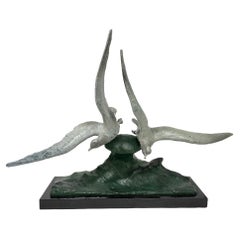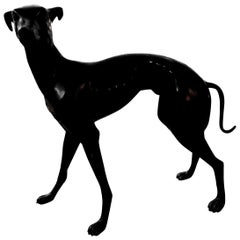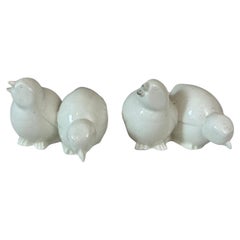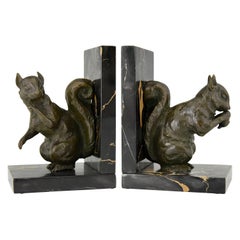Rene Papa Furniture
to
1
1
1
1
1
1
1
1
1
1
1
1
1
1
7,546
3,967
2,548
2,244
Creator: Rene Papa
Rene Papa, French Sculptor 19th-20th Century Bronze Sculpture, 1930s
By Rene Papa
Located in Delft, NL
Rene Papa, French sculptor 19th - 20th century bronze sculpture, 1930s.
A bronze with green patina sculpture of birds flying on a sea wave o...
Category
Early 20th Century French Rene Papa Furniture
Materials
Marble, Bronze
Related Items
20th Century Bronze Whippet Sculpture
Located in Houston, TX
20th century Bronze whippet sculpture.
Beautifully executed Hollywood Regency bronze whippet or greyhound statue or figure from the Mid-20t...
Category
20th Century Hollywood Regency Rene Papa Furniture
Materials
Bronze
20th century French Pair of Earthenware Chicks, 1930s
By Jacques Adnet
Located in LEGNY, FR
A lovely pair of Art Deco crackled earthenware chicks in the style of Jacques Adnet, in good condition.
Numbered under the base. Excellent quality.
Category
1930s French Art Deco Vintage Rene Papa Furniture
Materials
Earthenware
19th Century French Bronze Animal Sculptures
Located in Los Angeles, CA
Pair of finely chaste bronze and dore bronze of dog and cat. Very life like.
Category
19th Century French Neoclassical Antique Rene Papa Furniture
Materials
Bronze
19th Century French Bronze Sculpture
Located in Atlanta, GA
This exquisite 19th-century French bronze sculpture captures the essence of rural life through the figure of a young peasant boy. The boy is depicted with a charming, rustic appeal,...
Category
19th Century Italian Antique Rene Papa Furniture
Materials
Metal, Bronze
Bronze And Onyx Lizard Sculpture, Late 19th Early 20th Century
Located in MARSEILLE, FR
Bronze lizard, as if exposing itself to the rays of the sun, on an onyx base
It is necessary to note the very beautiful details in the realization of the lizard, the finesse of the ...
Category
Late 19th Century European Art Nouveau Antique Rene Papa Furniture
Materials
Onyx, Bronze
Early 20th Century Bronze Sculpture of Carrying Man by Belgian Sculptor Demanet
By Victor Demanet
Located in North Miami, FL
Early 20th century patinated bronze sculpture of carrying man by belgian sculptor Victor Demanet and BL Paris
By: Victor Demanet, BL Paris
Material: bronze, copper, metal
Technique:...
Category
Early 20th Century French Expressionist Rene Papa Furniture
Materials
Bronze, Metal, Copper
H 5 in W 3 in D 4.5 in
Meissen Porcelain Sculpture, 19th Century Style, 20th Century.
By Meissen Porcelain
Located in Saint-Ouen, FR
Meissen porcelain sculpture, 19th century style, 20th century.
A Meissen porcelain sculpture of a Chinese man in traditional dress, 20th century, 19th century style.
H: 17cm, D: 6cm
Category
20th Century German Chinoiserie Rene Papa Furniture
Materials
Porcelain
19th Century French Bronze Sculpture of a Priest
Located in Winter Park, FL
A 19th century French cast bronze statue of a Catholic priest. Fine casting with beautiful patina. Signed on base: Gaul
Weight: 22 Lbs
Dimensions: 20"H x 8"W x 7"D
Base: 5.5" x 4.75"...
Category
19th Century French Antique Rene Papa Furniture
Materials
Bronze
20th Century Abstract Bronze Sculpture
Located in Bagshot, GB
A fantastic piece of abstract art in the form of a bronze sculpture.
With sharp casting in the form of a shell motif and figurine and with a great verdi gris patina.
Category
Mid-20th Century European Mid-Century Modern Rene Papa Furniture
Materials
Bronze
20th Century Tennis Player Bronze Sculpture / Trophy, Italy, 1930s
Located in Buenos Aires, Olivos
Midcentury tennis player bronze sculpture / Trophy. Italy, 1930s.
Very nice Italian bronze figure. Mounted over black Portoro marble.
Category
Mid-20th Century Italian Mid-Century Modern Rene Papa Furniture
Materials
Marble, Bronze
J. Frödiig, Swedish Sculptor, Bronze Sculpture on Marble Base, Mid-20th Century
Located in Copenhagen, DK
J. Frödiig, Swedish sculptor. Bronze sculpture on a marble base, mid-20th century.
Measures: 13.5 x 10.5 cm.
In very good condition.
Signed.
Category
Mid-20th Century Danish Rene Papa Furniture
Materials
Marble, Bronze
H 5.12 in W 3.94 in D 2.37 in
Pair French 19th/20th Century Gilt-Bronze Sculptures of The Marly Horses Lamps
By Guillaume Coustou
Located in Los Angeles, CA
A Fine Pair of French 19th/20th Century Gilt-Bronze Sculptures of "The Marly Horses" (Now turned into lamps) After the original by Guillaume Coustou (French, 1677-1746). The large pair of equestrian bronze sculptures, finished in a gold patina, each depicting rearing horses with their groom, both raised on oval a black slate and Bardiglio marble bases and fitted with modern electrical twin-light brass fittings and cream colored shades. The base on an ebonized wooden platform. Circa: Paris, 1900-1920.
Sculpture & Base Height: 31 1/4 inches (79.8 cm)
Base Width: 21 3/4 inches (55.3 cm)
Base Depth: 12 3/4 inches (32.4 cm)
Height to top of (Adjustable) shade fitting: 48 1/4 inches (122.6 cm)
Shade Height: 15 inches (38.1 cm)
Shade Width: 26 inches (66.1 cm)
Shade Depth: 20 inches (50.8 cm)
The original Marly Horses are two 1743–1745 Carrara marble sculpted groups by Guillaume Coustou. They were commissioned by Louis XV of France for the trough at the entrance to the grounds of his château de Marly. Coustou's last works, they were intended to replace two other sculpted groups, Mercury on Pegasus and Pegasus, Renown of Horses, both by Antoine Coysevox, which had been removed to the Tuileries Gardens in 1719.
Louis XV chose the modellos in 1743 and the full-size sculptures were completed in only two years, being installed at Marly in 1745. They proved highly successful in reproduction, particularly on a smaller scale, and prefigured Théodore Géricault and other Romantic artists' obsession with equestrian subjects. The Marly horses were later also used as the central motif of the monochrome 819-line RTF/ORTF test card which was used on TF1 from 1953 until 1983.
The originals were moved to the place de la Concorde in Paris in 1794 and Louis-Denis Caillouette (1790–1868) restored them in 1840. In 1984 it was concluded that the annual military parades on 14 July were damaging the sculptures and they were replaced by marble copies produced by Michel Bourbon in the studio of a subsidiary of Bouygues. The latter also gained the right to an extra copy, which was placed in Bouygues's social building. The original sculptures were moved to a former courtyard in the Richelieu wing of the Louvre Museum, which was renamed the 'cour Marly' in their honour, whilst Bourbon's two main copies were moved to the originals' first site near the trough at Marly, with work overseen by the architect Serge Macel.
Guillaume Coustou the Elder (29 November 1677, Lyon – 22 February 1746, Paris) was a French sculptor of the Baroque and Louis XIV style. He was a royal sculptor for Louis XIV and Louis XV and became Director of the Royal Academy of Painting and Sculpture in 1735. He is best known for his monumental statues of horses made for the Chateau of Marly, whose replicas now stand in the Place de la Concorde in Paris.
Coustou was a member of a family of famous sculptors; his uncle, Antoine Coysevox, was a royal sculptor; his elder brother, Nicolas Coustou was a sculptor, and his son Guillaume Coustou the Younger also become a noted royal sculptor. Like his older brother, he won the (Prix de Rome) of the Royal Academy which entitled him to study for four years at the French Academy in Rome. However, he refused to accept the discipline of the academy, gave up his studies, set out to make his own career as an artist. He worked for a time in the atelier of the painter Pierre Legros, and eventually returned to Paris.
Upon his return to Paris, he assisted his uncle Coysevox in making two monumental equestrian sculptures, Fame and Mercury, for the Château de Marly, the new residence of Louis XIV near the Palace of Versailles, where he went to escape the crowds and ceremony of the Palace. He later (1740–1745), made his own horses, The Horses of Marly, his most famous works, to replace them. The horses reinvent the theme of the colossal Roman marbles of the Horse Tamers in the Piazza Quirinale, Rome. They were commissioned by Louis XV in 1739 and installed in 1745 at the Abreuvoir ("Horse Trough") at Marly. The horses were considered masterpieces of the grace and expressiveness of the French Late Baroque or Rococo style. After the Revolution they were moved from Marly to the beginning of the Champs-Élysées on the Place de la Concorde. The originals were brought indoors for protection at the Louvre Museum in 1984.
In 1704 Coustou was received into the Académie royale de peinture et de sculpture. The work he made to mark his entrance was Hercules on the Pyre, now in the Louvre. It displays the special hallmark of the Baroque, a twisting and rising transverse pose, as well as highly skillful carving. He rose to become Director of the academy in 1733.
Another of his major works from his later career, the statue of Maria Leszczynska, (1731)is on display at the Louvre.
Coustou also created two colossal monuments, The Ocean and the Mediterranean among other sculptures for the park at Marly; the bronze Rhone, which formed part of the statue of Louis XIV at Lyons, and the sculptures at the entrance of the Hôtel des Invalides. Of these latter, the bas-relief representing Louis XIV mounted and accompanied by Justice and Prudence was destroyed during the Revolution, but was restored in 1815 by Pierre Cartellier from Coustou's model; the bronze figures of Mars and Minerva (1733–34), on either side of the doorway, were not interfered with.
In 1714 for Marly he collaborated in two marble sculptures representing Apollo Chasing Daphne (both at the Louvre), in which Nicolas Coustou sculpted the Apollo and Guillaume the Daphne. About the same time he was commissioned to produce another running figure in marble, a Hippomenes designed to complement an Atalanta copied from the Antique by Pierre Lepautre...
Category
Early 1900s French Louis XV Antique Rene Papa Furniture
Materials
Marble, Bronze
H 31.25 in W 21.75 in D 12.75 in
Previously Available Items
Art Deco Bronze Squirrel Bookends Rene Papa, 1930
By Rene Papa
Located in Antwerp, BE
Pair of Art Deco bronze bookends modelled as two squirrels by the French artist René Papa. The bronzes have a lovely green patina and are mounted on fine Portor marble bases, circa 1...
Category
1930s European Art Deco Vintage Rene Papa Furniture
Materials
Marble, Bronze
Rene Papa furniture for sale on 1stDibs.
Rene Papa furniture are available for sale on 1stDibs. These distinctive items are frequently made of stone and are designed with extraordinary care. If you’re looking for additional options, many customers also consider furniture by Robert Bousquet, Georges H. Laurent, and Edouard-Marcel Sandoz. Prices for Rene Papa furniture can differ depending upon size, time period and other attributes — on 1stDibs, these items begin at $3,107 and can go as high as $3,107, while a piece like these, on average, fetch $3,107.



